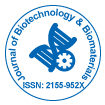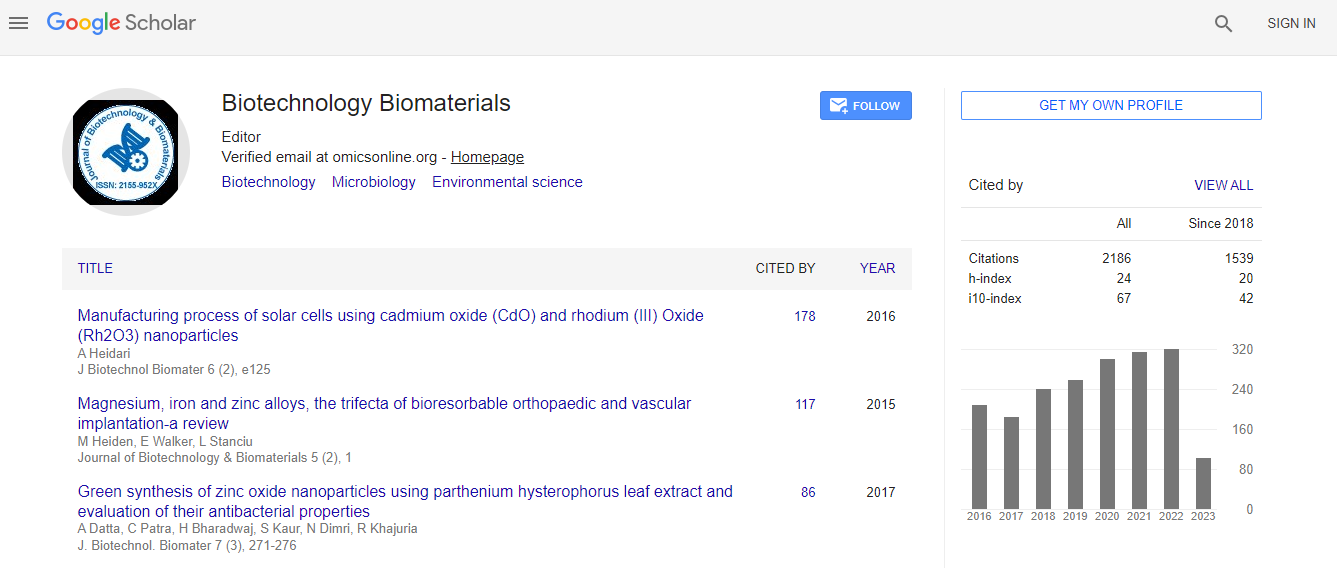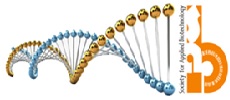Our Group organises 3000+ Global Conferenceseries Events every year across USA, Europe & Asia with support from 1000 more scientific Societies and Publishes 700+ Open Access Journals which contains over 50000 eminent personalities, reputed scientists as editorial board members.
Open Access Journals gaining more Readers and Citations
700 Journals and 15,000,000 Readers Each Journal is getting 25,000+ Readers
Google Scholar citation report
Citations : 3330
Journal of Biotechnology & Biomaterials received 3330 citations as per Google Scholar report
Indexed In
- Index Copernicus
- Google Scholar
- Sherpa Romeo
- Open J Gate
- Genamics JournalSeek
- Academic Keys
- ResearchBible
- China National Knowledge Infrastructure (CNKI)
- Access to Global Online Research in Agriculture (AGORA)
- Electronic Journals Library
- RefSeek
- Hamdard University
- EBSCO A-Z
- OCLC- WorldCat
- SWB online catalog
- Virtual Library of Biology (vifabio)
- Publons
- Geneva Foundation for Medical Education and Research
- Euro Pub
- ICMJE
Useful Links
Recommended Journals
Related Subjects
Share This Page
Fabrication of thermo-responsive surfaces with nanocone array
3rd Annual Conference and Expo on Biomaterials
Qianqian Cui, Tianqing Liu, Kedong Song, Dan Ge, Shui Guan
Dalian University of Technology, China
ScientificTracks Abstracts: J Biotechnol Biomater
Abstract
Statement of the Problem: The bacterial adhesion to the solid surfaces and subsequent formation of biofilm are greatly harmful for the efficiency of material application and related processes. It is of important significance for protecting the environment and life health to study the formation mechanism of biofilm and the way of preventing the formation of biofilm. At present, we are working on fabricating the thermo-responsive material surfaces with nanocone array to regulate the bacterial adhesion and prevent biofilm formation, i.e. Bacterial cells are penetrated and killed by nanocone structures and thermo-responsive poly (N-isopropylacrylamide) (PNIPAAm) detaches and releases the dead cells and debrises through the change of temperature. Method & Technology: We have prepared hexagonally packed ordered alumina inverse taper-nanopores by using one-step hard anodizing and etching peeling of high purity aluminum foils followed by multistep mild anodizing and etching pore-widening. Then adopting template-based hot embossing copies the shapes of anodic aluminum oxide template onto the polymer surfaces on which the nononipple structures can be attained. These nononipples were transformed to nanocones by chemical dissolution. According to the type of substrate materials, suitable methods of grafting thermo-responsive poly (N-isopropylacrylamide) (PNIPAAm) were chosen to obtain the thermo-responsive materials with nanocone array. For example, the glass surface and polymer surface with nanocone array were grafted with PNIPAAm by the method of ARGET-ATRP and ultraviolet irrigation, respectively. Conclusion & Significance: Modulating the structural parameters of the thermo-responsive nanocone surfaces will realize the target of regulating bacterial adhesion, killing bacteria and releasing dead cells and their cell fragments. The material that is able to regulate bacterial adhesion and prevent biofilm formation belongs to physical environmental friendly materials, which provides new mentality for the control of bacterial adhesion and biofilm formation. Recent publications 1. Ivanova E P, Hasan J, Webb H K and Truong V K (2012) Natural bactericidal surfaces: mechanical rupture of Pseudomonas aeruginosa cells by cicada wings. Small 8:2489-94. 2. Lee W, Ji R, Gosele U and Nielsch K (2006) Fast fabrication of long-range ordered porous alumina membranes by hard anodization. Nature Materials 5:741-747. 3. Li J, Li C, Chen C and Hao Q (2012) Facile method for modulating the profiles and periods of self-ordered threedimensional alumina taper-nanopores. ACS Applied Material & Interfaces 4:5678-5683. 4. Zhang W, Lin G, Li J and Xue H (2015) Fabrication of biomimetic polymer nanocone films with condensate micro drop self-removal function. Advanced Materials Interfaces 2: 1500238. 5. Li J, Zhu J and Gao X (2014) Bio-inspired high-performance antireflection and antifogging polymer films. Small 10:25782582.Biography
Qianqian Cui is studying for doctor degree in the Faculty of Chemical, Environmental and Biological Science and Technology, Dalian University of Technology. She has been studying the subject for nearly one year. She is very interested in the research on the fabrication of materials which prevent inherently biofilm formation by physical methods. They have produced the nanocone surfaces and firmly believe that the project will contribute to the development for bioactive materials.
Email:cqianq168@sina.com

 Spanish
Spanish  Chinese
Chinese  Russian
Russian  German
German  French
French  Japanese
Japanese  Portuguese
Portuguese  Hindi
Hindi 
